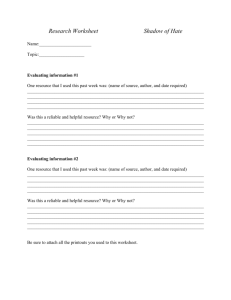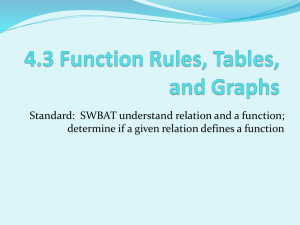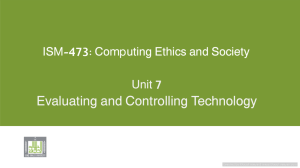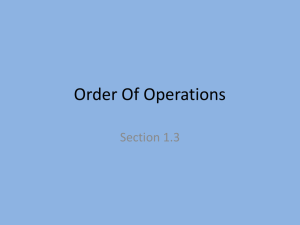Evaluating Information Resources
advertisement
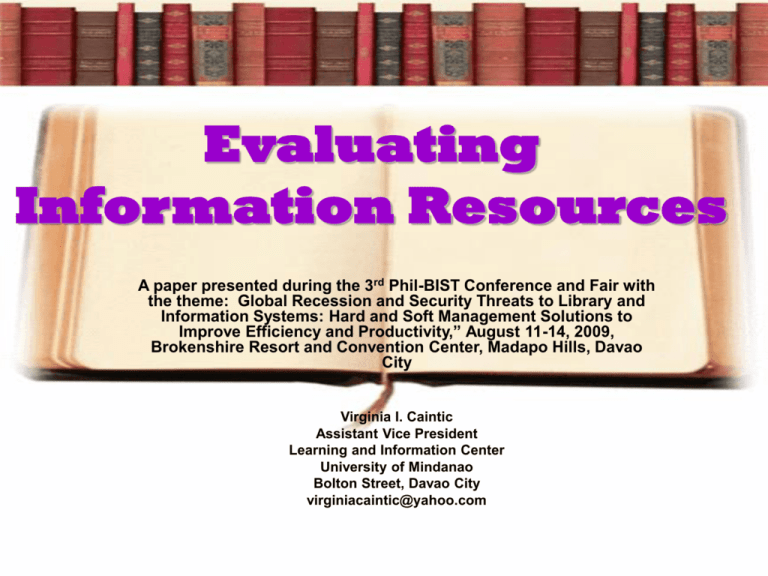
Evaluating Information Resources A paper presented during the 3rd Phil-BIST Conference and Fair with the theme: Global Recession and Security Threats to Library and Information Systems: Hard and Soft Management Solutions to Improve Efficiency and Productivity,” August 11-14, 2009, Brokenshire Resort and Convention Center, Madapo Hills, Davao City Virginia I. Caintic Assistant Vice President Learning and Information Center University of Mindanao Bolton Street, Davao City virginiacaintic@yahoo.com Why evaluate? As new technologies and formats emerge, the nature of the library’s collection changes. The type of library affect the mix of materials. (Gregory, 2006) THE CHANGING NATURE OF LIBRARY COLLECTIONS Gregory, Vicki L. 2006. Selecting and Managing Electronic Resources. Rev. Ed. N. Y: Neal-Schuman Pub. Evaluating Information Resources I. INITIAL APPRAISAL II. CONTENT ANALYSIS Evaluating Information Resources I. INITIAL APPRAISAL A. B. C. D. E. Author Date of Publication Edition or Revision Publisher Title of Journal Initial Appraisal A. Author 1. Author’s credentials 2. Has your instructors/professors mentioned this author? 3. Is the author associated with a reputable institution or organization? What are the basic values or goals of the institution or organization? INITIAL APPRAISAL B. Date of Publication 1. When was the source published? 2. Is the source current or out-of-date for your topic? INITIAL APPRAISAL C. Edition or Revision Is this a first edition of this publication or not? Also, many printings or editions may indicate that the work has become a standard source in the area and is reliable? If you are using a Web source, do the pages indicate revision dates? INITIAL APPRAISAL D. Publisher Note the publisher. If the source is published by a university press, it is likely to be scholarly. INITIAL APPRAISAL E. Title of Journal Is this a scholarly or a popular journal? If you need help in determining the type of journal, see Distinguishing Scholarly from Non-Scholarly Periodicals. Or you may wish to check your journal title in the latest edition of Katz's Magazines for Libraries for a brief evaluative description. CONTENT ANALYSIS A. B. C. D. E. Intended Audience Objective Reasoning Coverage Writing Style Evaluative Reviews CONTENT ANALYSIS A. Intended Audience What type of audience is the author addressing? Is the publication aimed at a specialized or a general audience? Is this source too elementary, too technical, too advanced, or just right for your needs? CONTENT ANALYSIS B. Objective Reasoning 1. Is the information covered fact, opinion, or propaganda? 2. Does the information appear to be valid and well-researched, or is it questionable and unsupported by evidence? 3. Are the ideas and arguments advanced more or less in line with other works you have read on the same topic? The more radically an author departs from the views of others in the same field, the more carefully and critically you should scrutinize his or her ideas. 4. Is the author's point of view objective and impartial? Is the language free of emotionarousing words and bias? CONTENT ANALYSIS C. Coverage Does the work update other sources, substantiate other materials you have read, or add new information? Does it extensively or marginally cover your topic? You should explore enough sources to obtain a variety of viewpoints. Is the material primary or secondary in nature? Primary sources are the raw material of the research process. Secondary sources are based on primary sources. Scholars use this primary material to help generate historical interpretations--a secondary source. CONTENT ANALYSIS D. Writing Style Is the publication organized logically? Are the main points clearly presented? Do you find the text easy to read, or is it stilted or choppy? Is the author's argument repetitive? CONTENT ANALYSIS E. Evaluative Reviews 1. Locate critical reviews of books in a reviewing source, such as Book Review Index, Book Review Digest, OR Periodical Abstracts. 2. Do the various reviewers agree on the value or attributes of the book or has it aroused controversy among the critics? 3. For Web sites, consider consulting one of the evaluation and reviewing sources on the Internet. Evaluating Information Resources Electronic Resources 1. Coverage of subject 2. Accuracy of content 3. Currency 4. Ease of use 5. Ability of the library to implement the technology Evaluating Information Found on the Internet Excellent resources reside along side the most dubious. The Internet epitomizes the concept of Caveat lector: Let the reader beware. What to consider: 1. 2. 3. 4. 5. 6. 7. Authorship Publishing body Point of view or bias Referral to other sources Verifiability Currency How to distinguish propaganda, misinformation and disinformation 8. The mechanics of determining authorship, publishing body, and currency on the Internet Evaluating Information Found on the Internet 1. Authorship is perhaps the major criterion used in evaluating information. 2. The publishing body also helps evaluate any kind of document you may be reading. Are there headers, footers, or a distinctive watermark that show the document to be part of an official academic or scholarly Web site? On the Internet, ask the following questions to assess the role and authority of the "publisher", which in this case means the server (computer) where the document lives: • Can you contact the site Webmaster from this document? Evaluating Information Found on the Internet • If not, can you link to a page where such information is listed? Can you tell that it’s on the same server and in the same directory (by looking at the URL)? • Is this organization recognized in the field in which you are studying? • Is this organization suitable to address the topic at hand? • Can you ascertain the relationship of the author and the publisher/server? Was the document that you are viewing prepared as part of the author’s professional duties (and, by extension, within his/her area of expertise)? • Or is the relationship of a casual or forfee nature, telling you nothing about the author’s credentials within an institution? • Can you verify the identity of the server where the document resides? Internet programs such dnslookup and whois will be of help. • Does this Web page actually reside in an individual’s personal Internet account, rather than being part of an official Web site? This type of information resource should be approached with the greatest caution. Hints on identifying personal pages are available in Understanding and Decoding URLs. Evaluating Information Found on the Internet 3. Point of view or bias reminds us that information is rarely neutral. Because data is used in selective ways to form information, it generally represents a point of view. Every writer wants to prove his point, and will use the data and information that assists him in doing so. When evaluating information found on the Internet, it is important to examine who is providing the "information" you are viewing, and what might be their point of view or bias. Evaluating Information Found on the Internet Steps for evaluating point of view are based on authorship or affiliation: • First, note the URL of the document. • Does this document reside on the Web server of an organization that has a clear stake in the issue at hand? – If you are looking at a corporate Web site, assume that the information on the corporation will present it in the most positive light. If you are looking at products produced and sold by that corporation, remember: you are looking at an advertisement. – If you are reading about a political figure at the Web site of another political party, you are reading the opposition. Evaluating Information Found on the Internet Does this document reside on the Web server of an organization that has a political or philosophical agenda? - Never assume that extremist points of view are always easy to detect. Some sites promoting these views may look educational. Many areas of research and inquiry deal with controversial questions, and often the more controversial an issue is, the more interesting it is. When looking for information, it is always critical to remember that everyone has an opinion. Because the structure of the Internet allows for easy self publication, the variety of points of view and bias will be the widest possible. Evaluating Information Found on the Internet 4. Referral to and/or knowledge of the literature refers to the context in which the author situates his or her work. The following criteria serve as a filter for all formats of information: • The document includes a bibliography. • The author alludes to or displays knowledge of related sources, with proper attribution. • The author displays knowledge of theories, schools of thought, or techniques usually considered appropriate in the treatment of his or her subject • If the author is using a new theory or technique as a basis for research, he or she discusses the value and/or limitations of this new approach. • If the author's treatment of the subject is controversial, he or she knows and acknowledges this. Evaluating Information Found on the Internet 5.Accuracy or verifiability of details is an important part of the evaluation process, especially when you are reading the work of an unfamiliar author presented by an unfamiliar organization, or presented in a non-traditional way. Criteria for evaluating accuracy include: • For a research document, the data that was gathered and an explanation of the research method(s) used to gather and interpret it are included. • The methodology outlined in the document is appropriate to the topic and allows the study to be duplicated for purposes of verification. • The document relies on other sources that are listed in a bibliography or includes links to the documents themselves. The document names individuals and/or sources that provided non- published data used in the preparation of the study. • The background information that was used can be verified for accuracy Evaluating Information Found on the Internet 6.Currency refers to the timeliness of information. In printed documents, the date of publication is the first indicator of currency. • If no date is given in an electronic document, you can view the directory in which it resides and read the date of latest modification Evaluating Information Found on the Internet • If you found information using one of the search engines available on the Internet, such as AltaVista or InfoSeek, a directory of the Internet such as Yahoo, or any of the services that rate World Wide Web pages, you need to know: 1. How the search engine decides the order in which it returns information requested. Some Internet search engines "sell" top space to advertisers who pay 2. That Internet search engines aren't like the databases found in libraries. Library databases include subject headings, abstracts, and other evaluative information created by information professionals to make searching more accurate. In addition, library databases index more permanent and reliable information. 2. How that search engine looks for information, and how often their information is updated. An excellent source for search engine information is Search Engine Showdown, written by Greg R. Notess. Evaluating Information Found on the Internet • All information, whether in print or by byte, needs to be evaluated by readers for authority, appropriateness, and other personal criteria for value. • If you find information that is "too good to be true", it probably is. Never use information that you cannot verify. Evaluating Information Found on the Internet • Establishing and learning criteria to filter information you find on the Internet is a good beginning for becoming a critical consumer of information in all forms. "Cast a cold eye" (as Yeats wrote) on everything you read. • Question it. Look for other sources that can authenticate or corroborate what you find. Learn to be skeptical and then learn to trust your instincts. © 1996 Elizabeth E. Kirk References Used: http://www.library.jhu.edu/researchhelp/general/evaluating/index.html Conclusion The American Library Association affirms that all libraries are forums for information and ideas, and that the following basic policies should guide their services (Art. 1 & 2 of the Library Bill of Rights). • Books and other library resources should be provided for the interest, information, and enlightenment of all people of the community the library services. • Libraries should provide materials and information presenting all points of view on current and historical issues. Thank you and Madayaw…. Virginia I. Caintic Assistant Vice President Learning and Information Center University of Mindanao Bolton Street, Davao City virginiacaintic@yahoo.com References Gregory, Vicki L. 2006. Selecting and Managing Electronic Resources. Rev. Ed. N. Y: Neal-Schuman Pub. Mason-Robinson, Sally. 1996. Developing and Managing Video Collections. N.Y. : Neal-Schuman Pub. Cassell, Kay Ann. 1999. Developing Reference Collections and Services in an Electronic Age. N.Y. : Neal-Schuman Pub. http://www.library.jhu.edu/researchhelp/general/evaluating/i ndex.html
